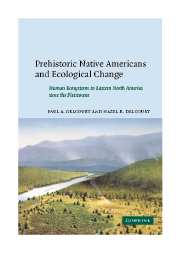 Prehistoric Native Americans and Ecological Change
Prehistoric Native Americans and Ecological Change 1 - The need for a new synthesis
Published online by Cambridge University Press: 30 October 2009
Summary
THE MYTH OF THE NATURAL MAN
The concept of the Native American as “noble savage,” living in harmony with nature, stems largely from the writings of the French philosopher, Rousseau, who lived from AD 1712 to 1778. Rousseau contrasted the “natural man,” who lived in the unspoiled wilderness, with the “civilized man,” who lived in society and sought to conquer the wilderness (Dolph, 1993). The concept of the noble savage was used in describing Native Americans by European American colonists of the eighteenth and nineteenth centuries, and those early descriptions became the basis for subsequent interpretations of the “presettlement” North American landscape by environmental historians and historical ecologists (Cronon, 1983; Crosby, 1986; Russell, 1997; Krech, 1999). The prevailing viewpoint of early twentieth-century ecologists was that human interference with natural succession began with European American settlement, and that in prehistoric times the vegetation was in equilibrium with climate and other environmental factors, including aboriginal human presence (Clements, 1936).
The debate among ecologists
Day (1953) was among the first academic ecologists to question this assumption. He argued that at the time of first European contact, the landscape of Eastern North America was not an unbroken virgin forest that had not been disturbed significantly by activities of Native Americans. Rather, settlers often described large tracts of open forest with little understory. Day cited ethnographic accounts (e.g., Densmore, 1927) to infer that prehistoric and historic Indians of New England drew upon the forest for a large variety of products.
- Type
- Chapter
- Information
- Prehistoric Native Americans and Ecological ChangeHuman Ecosystems in Eastern North America since the Pleistocene, pp. 3 - 10Publisher: Cambridge University PressPrint publication year: 2004


